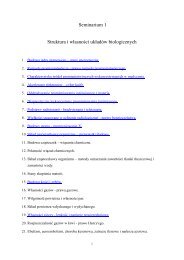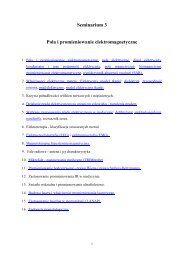8_Dental_Radiography
8_Dental_Radiography
8_Dental_Radiography
You also want an ePaper? Increase the reach of your titles
YUMPU automatically turns print PDFs into web optimized ePapers that Google loves.
Student’s Laboratory, Department of Biophysics<br />
V. Detailed instruction<br />
Exercise preparation. Set up a new folder on your private network drive (U). All files<br />
created during the exercise should be saved in this folder. Any files saved at different<br />
locations, will be deleted.<br />
Setting optimal time of exposition of the radiographic films.<br />
Properties of the radiographic film may be defined by using the sensitometer scale<br />
(dependence of the blackening of the film upon the exposition). Radiogram with the<br />
sensitometer scale for this lab was done in such a way: rectangle 1 (lightest) on the scale<br />
was irradiated with X-ray produced by the lamp with anode voltage 30 kVp, anode<br />
current 3 μA and the time of exposition 1s. Every next rectangle was irradiated using<br />
twice larger exposition (3, 6, 12, 24…and so on, in μAs).<br />
Turn on scanner Agfa SnapScan 1236u and apply program Scan Wise (see Section VI)<br />
for scanning one of the sensitometer scales. Apply resolution 300 dpi. Save file in BMP<br />
format in your folder.<br />
Use Pomiary program (see Section IX) to measure an average value of the grey-scale<br />
level in each of 21 rectangular areas of the sensitometer scale. Write the measured gray<br />
levels in the table.<br />
In Statistica program create the graph of the grey level dependence on exposition (apply<br />
the logarithm scale for exposition). Interpret the graph course.<br />
Decide which exposition should be most accurate to achieve the best contrast for<br />
recognizing differences in absorption (extinction) of radiation by the different regions of<br />
irradiated object.<br />
Taking under attention the fact, that the dentist's rtg plate (film) has the similar<br />
properties to the plate with sensitometer scale, count the optimal exposition as well as<br />
the optimal time of exposition for anodal current equal to 100 μA. These parameters<br />
you will apply for settlement of proper exposition times during collection of the tooth’s<br />
radiograms.<br />
Collection of radiographic pictures of tooth.<br />
Radiograms are prepared with laboratory X-ray lamp XR-100 powered with Eclipse II<br />
power supply (see Section VII). A special radiographic film SD-SPEEDX EXPOSURE<br />
CHART (see Section VIII) is applied.<br />
Place the box with a tooth in the openable chamber in column with the X-ray lamp.<br />
Since radiation is created by the laboratory XR-lamp in form of a narrow cylinder<br />
(about 2 cm of diameter), the tooth has to be located exactly in centre of the chamber.<br />
Turn on the power unit of the lamp and set the anodal current equal to 100 μA.<br />
Four radiograms have to be done using the different settings of anodal voltage and<br />
different times of exposition (emission of radiation must be turn on and off manually;<br />
check time of exposition with your clock or stopper):<br />
(1) anodal voltage equal to 30 kVp; time of exposition equal to calculated earlier optimal<br />
time of exposition;<br />
(2) anodal voltage equal to 30 kVp; time of exposition half of the calculated earlier<br />
<strong>Dental</strong> <strong>Radiography</strong> 2





